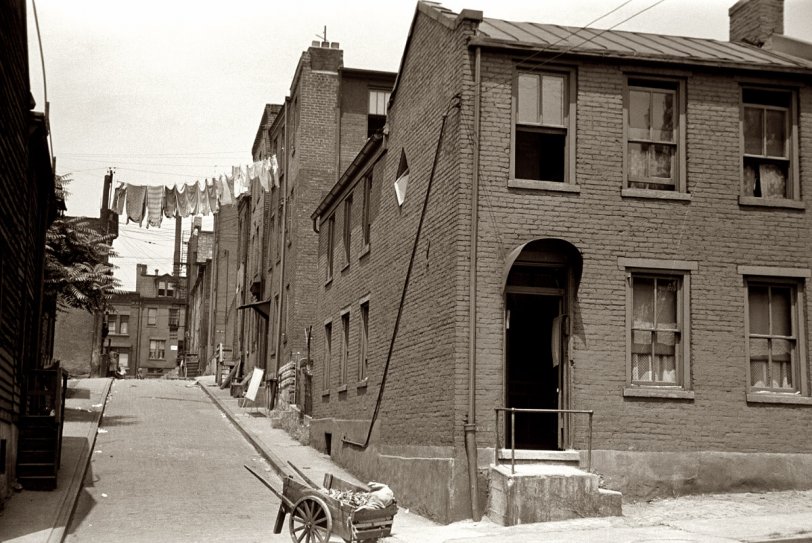


Framed or unframed, desk size to sofa size, printed by us in Arizona and Alabama since 2007. Explore now.
Shorpy is funded by you. Patreon contributors get an ad-free experience.
Learn more.

- Baldwin 62303
- Baldwin VO-1000
- Cold
- No expense spared
- Tough Guys
- Lost in Toyland
- And without gloves
- If I were a blindfolded time traveler
- Smoke Consumer Also Cooks
- Oh that stove!
- Possibly still there?
- What?!?
- $100 Reward
- Freeze Frame
- Texas Flyer wanted
- Just a Year Too Soon
- WWII -- Replacing men with women at the railroad crossing.
- Yes, Icing
- You kids drive me nuts!
- NOT An Easy Job
- I wonder
- Just add window boxes
- Icing Platform?
- Indiana Harbor Belt abides
- Freezing haze
- Corrections (for those who care)
- C&NW at Nelson
- Fallen Flags
- A dangerous job made worse
- Water Stop
Print Emporium
The Hill: 1938

July 1938. Houses on "The Hill" slum section of Pittsburgh. View full size. 35mm nitrate negative by Arthur Rothstein for the Farm Security Administration.
What the Hill
In many cities and towns, an area known as "The Hill" is an affluent area. When I first visited Pittsburgh in 1974 to find a place to live prior to attending graduate school at the University of Pittsburgh, I was looking at a city map and saw "The Hill" listed as an area not far from the Pitt campus. Thinking it might be a nice area, I drove up there. Big surprise! It was "lock the doors and roll up the windows" time. Is it any better today?
Wylie Avenue Days
I believe the Rick Sebak documentary you're thinking of is Wylie Avenue Days
Not the power pole
Based on the sag, I'd say that the clothesline isn't attached to the power pole but rather to something on the building across the street. We're running into the old question of perspective in a two dimensional representation of a three dimensional situation.
The sage problem is inherent in a laundry line - you don't want it too taut or the weight of the clothes could break the line or contraction during the winter. And in that sort of situation you really don't want to have to splice the line!
Clothesline
I'm intrigued by the clothesline. Someone had to climb a power pole to rig that! I have one of these in my backyard in the midwest because it allows one end to be high and out of the way. Kids can run around in safety under it. Have not solved the sag problem though.
The Hill? Which one?
Which hill? Pittsburgh is known to have multiple hills...
There was 20 inclined cable railways in Pittsburgh all around the hills of the city... now there are only two of them...
Dave... did you find any great old photos of the Pittsburgh old inclined railways?
I found some old picts at the Library of Congress...
http://www.funimag.com/Funimag-Links-OldUSpictures.php
...but the quality is not so good compare to the picts you publish on your blog!
If you can find old picts of the Pittsburgh inclines that would be great!!
-----------------------------------------
Funimag, the web magazine about Funiculars
http://www.funimag.com
Funimag Photoblog
http://www.funimag.com/photoblog/
History of the Hill
The Hill district was long a place for immigrants. The Irene Kaufmann Settlement House helped people from Eastern Europe find baths and a decent life. There were a lot of different ethnic groups up there. Then, during World War I, more Southern Blacks came North for a better life. Others were brought in as strike breakers during the 1919 steel strike. The men were treated like cattle: they slept in box cars. When the strike ended, so did their wages. But the money helped build the so-called "Harlem Renaissance" of Black culture during the 1920's.
Look for documentaries by Rick Sebak. He does a lot of stuff about Pittsburgh, and he's made one film about the Hill. He's good, if you don't mind corn.
Also known as the Hill
Also known as the Hill District.
























On Shorpy:
Today’s Top 5